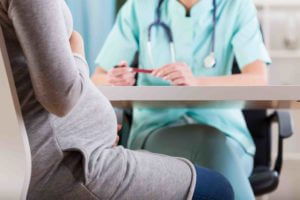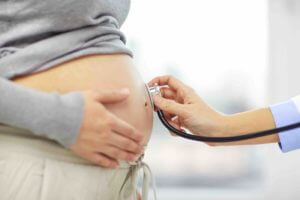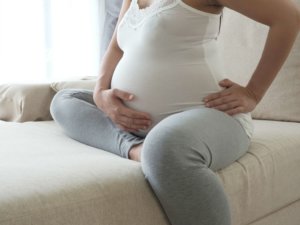Trisomy 18 is a rare genetic defect that develops in early pregnancy. For the parents-to-be, the suspicion is tragic news and causes anxiety. In such a situation, it is helpful to take a close look at the implications of the diagnosis.
What are the possible causes, how can the condition be detected? And how does a trisomy develop in the first place? Why is the ultrasound of girls so important in the case of trisomy 18?
You can find everything about the topic of trisomy 18 here in the article.
Table of contents
How Can A Trisomy Develop?
A genetic defect such as trisomy 18 develops at a very early stage of pregnancy. During the process of meiosis, the cells are divided and the recombination of the genetic material of the parents results in an individual genome of the embryo.
In this early, so-called mature division of the cells, a combination error can occur, which suddenly connects 3 chromosomes instead of two. The chromosome that is present three times is then the eponym – in the case of Edwards syndrome this is chromosome number 18.
Due to this defective fusion, all further resulting cells are also defective. This process is also called chromosomal aberration.Causal reasons for the genetic damage have not yet been determined, but the age of the mother plays a decisive role in the frequency of trisomy 18.
The triple occurrence of the 18th chromosome as a genomic mutation is associated with serious damage and malformations, girls are affected three times more often than boys.
The Manifestations Of Trisomy 18:
Four different manifestations of Edwards syndrome are known.
Free Trisomy 18
All cells have a triple chromosome 18. This form of trisomy applies to 95% of affected children and results from the random error in the recombination of the parental genome.
Mosaic trisomy 18
In the course of embryogenesis, i.e. the development of the baby, cells with three pairs of chromosome 18 can arise and multiply. The later this defective cell division occurs, the gentler the symptoms are in expression.
Partial Trisomy 18
In this genetic defect, part of the chromosome is longer or duplicated. Often, the symptoms are then less severe.
Translocation Trisomy 18
This form of trisomy only occurs when one parent already carries the predisposition to trisomy 18 in the gene pool. It is very rare and little researched. Couples who already have a child with the condition usually get tested to see if they may carry such a recessive, balancing gene defect. In the case of a positive parental finding, a recurrence of the disease is very likely.
How Can The Diagnosis Be Made?
In about 85% of children, the diagnosis of trisomy 18 can be made in early pregnancy. About 15% of the children show the first symptoms only postnatally, and then sometimes even after the first months of life.
A clear prenatal statement is made by the Harmony test, a test for chromosome analysis, whose coverage by health insurance is often disputed despite its high accuracy.
Harmony Test
The Harmony Test is a blood test that examines maternal blood for traces of embryonic genetic material. The blood circulation of mother and child is connected through the umbilical cord and placenta, so that fetal DNA can be detected in the mother’s blood.
This is only possible from the 10th SSW. This genetic test can detect trisomies and mutations on the gonadal chromosomes. The Harmony test is non-invasive, so it does not pose a risk to the life of the unborn child.
Other prenatal examinations such as amniocentesis always carry a risk for the child. The test, which is uncomplicated in practical execution but highly demanding in scientific performance, is currently only performed in cases of increased risk of disease.
- Higher age of the expectant mother.
- Conspicuous first trimester screenings.
- Known chromosomal mutations in the immediate family.
In addition to the Harmony test, there is also the possibility of chromosomal analysis of the unborn child, as well as amniocentesis and biopsy of the placenta. Postnatally, an examination of lymphocytes from the infant’s blood can provide an accurate diagnosis of the condition.
Symptoms Of A Child With Trisomy 18
It must be made clear at the outset that not every child experiences all symptoms to the same degree. Symptoms vary, but there are no known cases that have only one symptom.
Prenatal Symptoms
- Cardiac dysfunction in heartbeat and heart volume.
- Cysts in the brain, face or skull area.
- Malformations of the facial bones and skull bones.
- Disturbance in the separation of the two hemispheres of the brain.
- Fluid accumulation in the neck area due to a disturbance of the drainage system of the cerebrospinal fluid (CSF).
- Growths of lymphatic tissue.
- Polydactyly (increased number of fingers and/or toes).
- Absence of the radius bone in the forearm.
- Fist syndrome: fist cannot be opened due to finger malformation.
- Inguinal hernias.
- Cleft mouth and palate.
- Malformations of the urinary organs.
- General growth retardation.
Postnatal Symptoms
- Very small and light baby, although not born prematurely.
- Four-finger furrow: visual separation of the palm by a line running horizontally and parallel to the knuckles without functional impairment.
- Seagull-like crying.
- Eye malformations.
- Ear malformations, hearing loss.
- Flat chest leading to difficult breathing.
- Muscle weakness, later muscle overextension: disturbed muscle tone.
- Severe disabilities of both gross and fine motor skills.
- Severely cognitively impaired.
You should be aware that while the designated symptoms may not all occur, normal organ function is severely damaged. Although a child with trisomy rarely shows all symptoms at the same time, each symptom in itself is a significant limitation.
An ultrasound for girls or boys can indicate many things in advance. Because female children are affected significantly more often – 3:1 ratio – the first trimester ultrasound will look very hard for symptoms of trisomy 18 in a girl.
The Course Of Trisomy 18
A young patient with trisomy 18 rarely reaches the age of 20. Well over 90% of children die before they are born. Only one in two children survives the first week on earth.
The children who survive the first week after birth and do not have severe organ malformations, about 40% can reach the first year of life. Although in trisomy 18 girls are more often affected, they have a higher life expectancy.
How severe and how quickly the disease progresses depends on the severity of symptoms, the type of trisomy 18, and medical care. A loving and caring social interaction with a trisomy child also improves the chances of life – and above all the quality of life of the sick child.
About 15 out of every 100 children born alive reach physical elementary school age. Children with trisomy 18 often have a good understanding of speech, although they are barely able to speak for themselves.
Gestures, facial expressions and memory are delayed, but in most cases allow communication of a simple nature. Through the Harmony test, parents of a child with trisomy 18 could prepare for birth and provide external oxygen, for example. Many of the children with Edwards syndrome die from respiratory failure because their lung function is insufficient to support themselves.
During their short lives, children with trisomy 18 naturally learn much more slowly than healthy children, but can learn to crawl or stand freely just as well. It just takes much longer and is usually further delayed by medical treatments.
The children who survive more than one year clearly show social and cognitive abilities, so they are usually not apathetic to their environment.
Is There A Treatment For Trisomy 18?
Trisomy 18 is not curable. Due to its high accuracy, the Harmony test is also an indicator for a late, medically indicated abortion of the child. The test result itself cannot provide an indication of the severity of the symptoms, although the type of trisomy 18 does provide a clue.
The symptoms of Edwards syndrome can often be treated surgically or adaptively, but cannot be cured. If the ultrasound indicates a trisomy in a girl or boy, expectant parents should address all possible symptoms.
It is not possible to raise and enroll a child with trisomy 18 as you would a child with trisomy 21, for example. Only the expression of symptoms can be contained and alleviated.
How Likely Is Another Trisomy In Subsequent Pregnancies?
No clear statement can be made about a probability. A chromosome analysis such as the Harmony test can show whether one parent is a carrier of the genetic information for translocation trisomy 18.
If so, the probability of occurrence of the genetic defect is very likely. Mothers of children with trisomy 18 have a slightly higher one percent risk of having another child with the diagnosis. However, there are no prophylactic measures or clear causes for the mutation.
Children with Edwards syndrome are, of course, a great burden to a family and sad news. Modern diagnostics such as the Harmony test do not make a decision for or against a child with trisomy 18. The test only holds the possibility for the expectant mother to better assess the situation.












